Chelsea Women have been an impressive unit this season continuing off where they left from the pandemic stricken season of 2019/20 where they were crowned champions. The following summer saw an influx of world-class players creating a squad equipped to take on the UEFA Women’s Champions League and defend their FAWSL crown.
While Emma Hayes has created a swashbuckling brand of football in a system that requires her to fit in several key attacking players, there is one position that remains a dilemma, who should be the starting centre-forward? Hayes has been trying to find the best system to try and shoehorn both Both Bethany England and Sam Kerr into the same lineup but realistically only one fits into the side naturally in its current state.
This tactical analysis will look to investigate and conclude who should be Chelsea Women’s starting striker and why. I will break down the team’s attacking tactics and use analysis to better understand the two striker’s style of play within this aforementioned system.
Current system
Hayes has predominately used a form of the 4-4-2 over the last two seasons with a few minor tweaks depending on the personnel available. This became more apparent when Kerr joined Chelsea giving her all-star forward line alongside England.
However, the arrival of Pernille Harder has effectively forced Hayes to rethink her tactics and come up with a more defined system to aptly field all her attacking talent. The answer, for now, seems to be the 4-2-3-1 formation. I will explain the current style of play which will create a better understanding of the strikers’ role here.
Chelsea play out from the back and move their way into midfield where one of the central midfielders will find spaces to attack and pass forward. There is an emphasis on playing fast, agile transition football with the ball moving from defence to attack in a fewer number of passes. The end result is to have players in the box to receive a cross or pullback and create an overrun.
When the ball reaches midfield, which starts the second phase of play, triggers other players to make movements including the attacking midfielder who makes a move towards the side the attack is being played through. Here the centre-forward is tasked with finding space by taking advantage of the space created by the other players. The first graphic illustrates the general patterns of movement of the players involved in the second phase of play and how it allows the forward to move more freely.
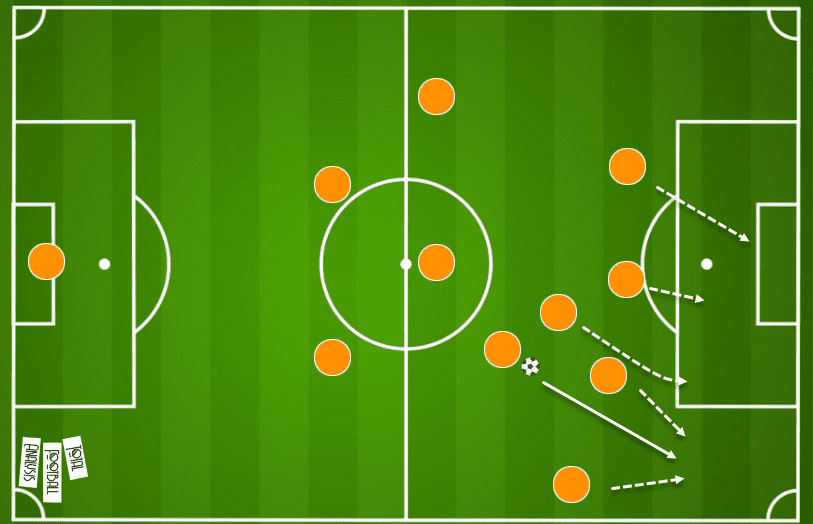
The forwards in this system have to be agile with their movements and use diagonal and vertical movements to be able to get onto the end attacking moves. The speed at which they transition and the way they move through the thirds means the strikers need to be aware of their position and know where the other forwards are. If a ball is played out wide and is crossed in by the right-winger, then the striker either needs to make a quick movement towards the ball to get away from a marker or use the same movement to allow a player behind her to get into a better goal scoring position.
What is also imperative to understand is that a core fundamental part of the system is the central midfielders who adopt a dual role as they are both the creators and controllers of the side. The double-pivot are both responsible for being Chelsea’s main creative foundation and providing a link between the attacking and defensive third. With Chelsea’s preference to run play through the wide spaces, one midfielder will look for passes in the halfspaces to involve the winger or full-back who provide the width with the number 10 moving across to create numerical superiority whilst the opposite side winger comes into a very narrow position next to the striker to create the overrun.
The centre-forwards’ movement, therefore, becomes important to use the space created by the others whether it be vertical sprints or short diagonal runs to get away from a nearby player.
The second central midfielder will pick up the first ball out from the back and move it forward and later become a more box-to-box type player and will typically make late runs forward if there aren’t enough players in the box. Both players are interchangeable especially when Ji so-Yun and Melanie Leupolz play.
What makes this an important part of the attacking third is the central midfielders dictate how Chelsea will attack. They have at times chosen to attack through the middle which invites quick and intricate passing exchanges that invites the ball side wide player, attacking midfielder and striker to drop and engage. The quick exchange will lead to the striker linking up play and become a playmaker of sorts but ultimately makes a diagonal run in behind to receive the final pass as the image suggests. Kerr exchanges passes with Erin Cuthbert and Ji and races through against Manchester United’s high line to create a 1 v 1 situation.
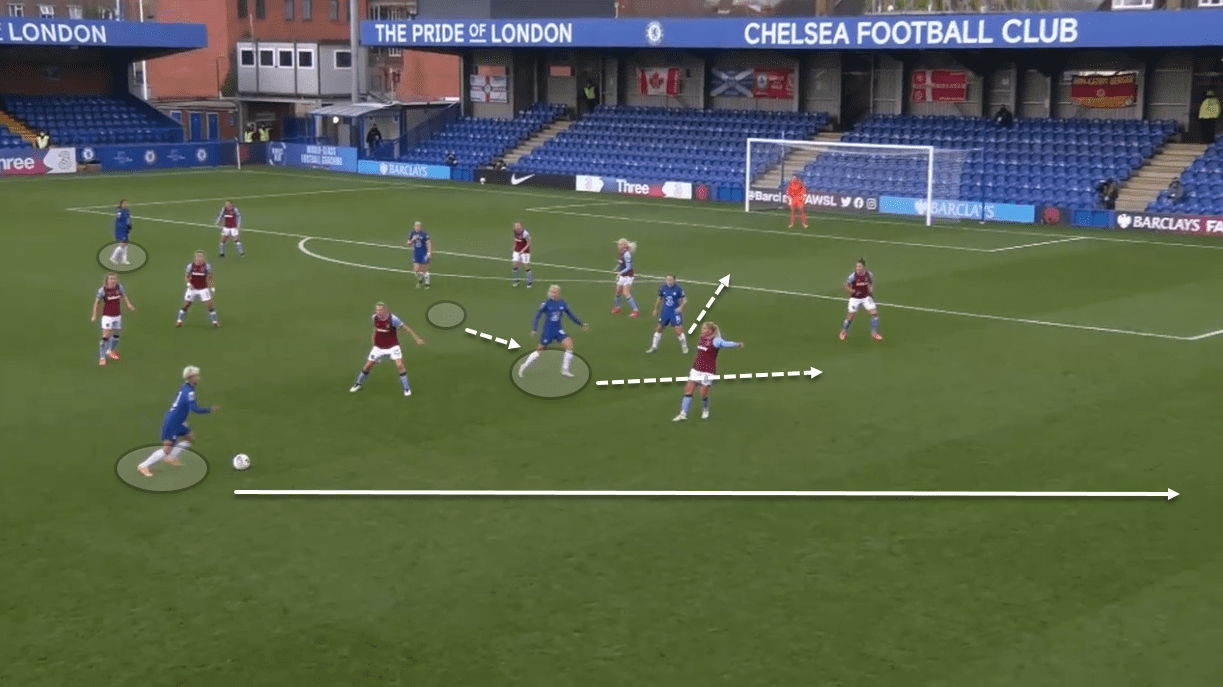
The next example begins a passage of play which illustrates Chelsea’s movements going wide starting with the second phase where Leupolz starts the initial move by dropping deep and passing it to Ji. She takes the ball forward and is faced by a wall of West Ham players but her thought is to move the ball out wide towards Maria Thorisdóttir (wide right out of frame).
What is worth noting is Harder’s movement across from a central position to the near side next to Kirby to create an overload on the off chance that Thorisdóttir were to come inside and pass it short. In reality, she opts for the cross with Kerr, Harder, England, and Kirby all in a position to make a quick, forward movement for any pass that comes into the box.
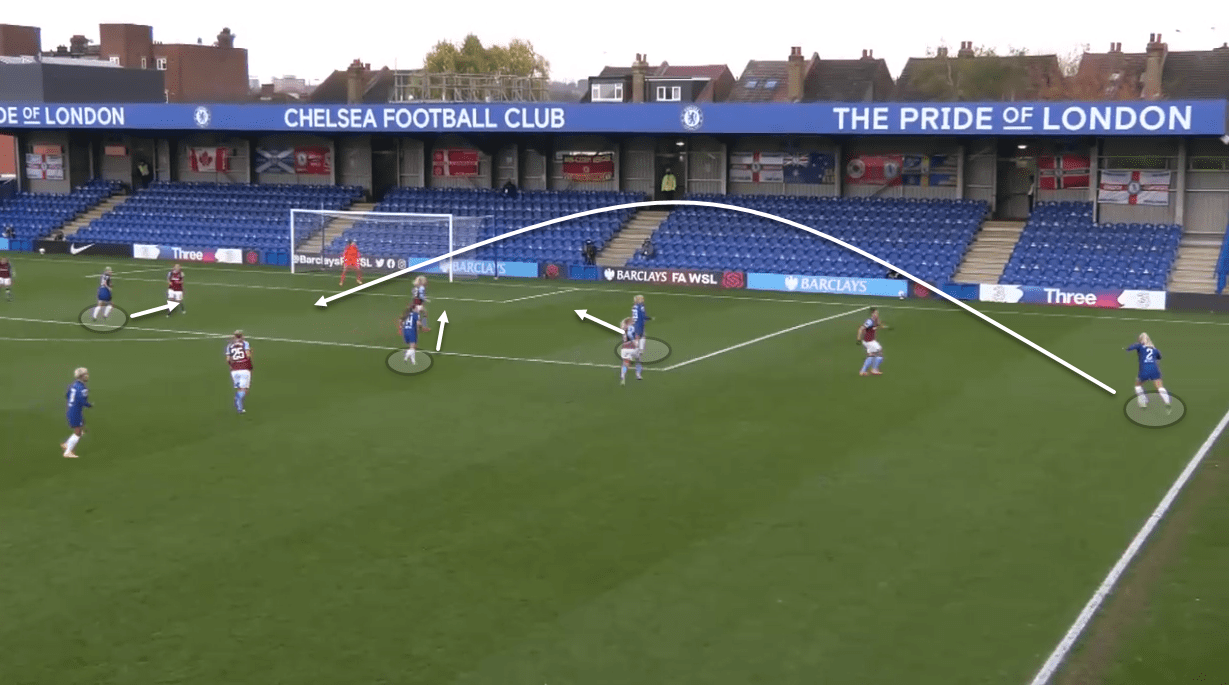
Now, we have seen that the centre-forward has two essential functions in Chelsea’s attacking setup. The first is their positioning which is based on the movement of other players around them that propels them find as much space as possible. Secondly, their movement becomes critical as they engage in deep link-up play if the team chooses to go central which means they need to be quick and accurate in their passing and have good link-up ability. But also, they will drift into the halfspaces in build-up to generate space on the shoulder of the defenders and make vertical movements.
Next, we’ll look at Kerr and England in more detail to conclude which striker is better suited to Hayes’ system.
Sam Kerr
Starting with Kerr, we know that she is a ‘complete forward’ who recognises opportunities to push possession forward by dropping deep bringing teammates into play or running the channels. Kerr when playing as a lone striker has been the team’s focal point, winning long balls like a target man, break lines like a poacher, press defenders like an advanced forward, or link-up play like a trequartista.
Being a complete forward means Kerr’s attributes and strengths are vast in theory and given the prolific seasons she had at Chicago Red Stars proves she’s more than capable. Though it is worth mentioning that the side was built around her, which isn’t exactly the case now. She is an excellent reader of the game and has the quality to create space for her teammates. While being a classic number nine, Kerr’s strengths include interchanges with her midfield sufficiently.
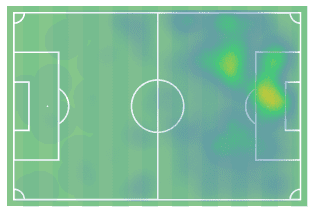
The heat map is pretty clear about her movement patterns with heavy activity in both the 18-yard box and the left half space. This is important because it shows Kerr’s versatility in being comfortable both in and outside the box and hints towards linking-up well with her full-back/midfielder. Many a time we see Kerr starting in a slightly wider area before coming inside whether it be to receive a cross or take on a through ball. This leads us onto Kerr’s major strength which is her ability to use and create space effectively.
Kerr’s ability to find and create this space in the final third is one of her better qualities. The Australian forward’s spatial awareness to move into different positions to create space is immeasurable. Her positioning is one of the most important aspects in this regard and is a major factor in how Chelsea transition and penetrate through the thirds. Being able to open space for other players or even herself in tight scenarios aids in trying to break down stubborn defences which is seen in the next example.
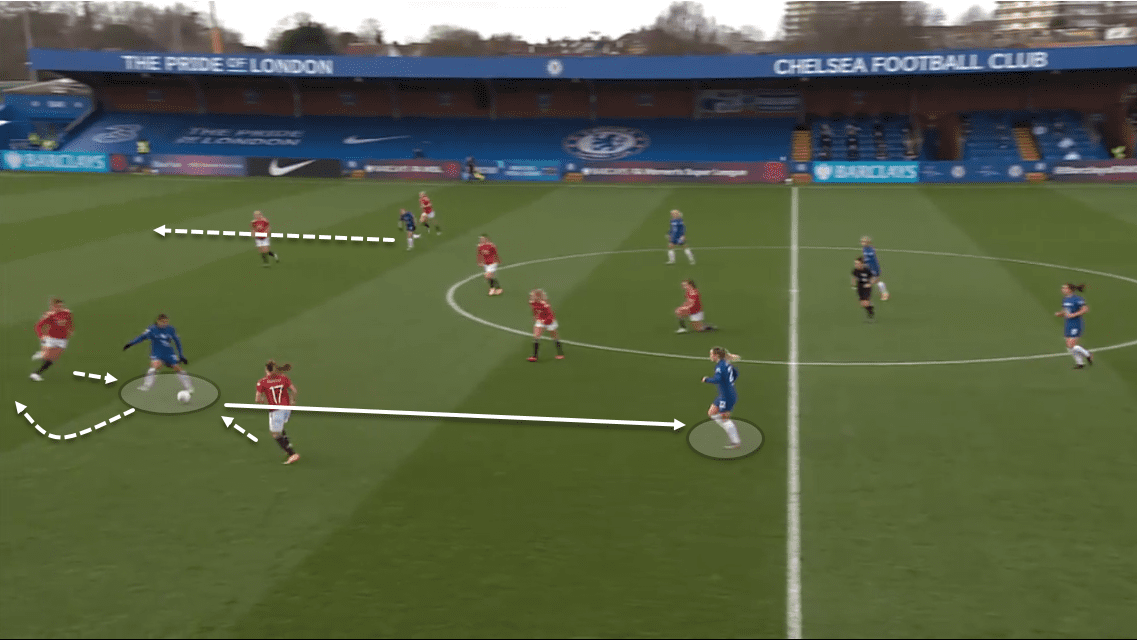
In this counter-attack against Manchester United, Chelsea win the ball back in central midfield and push forward for a counter-attack. Cuthbert wins the ball which prompts Kerr to move from her central position into a pocket of space between the defenders. Here she is ready to play a give-and-go with Cuthbert and make a diagonal run behind which in itself opens space and forces defenders to turn their focus away.
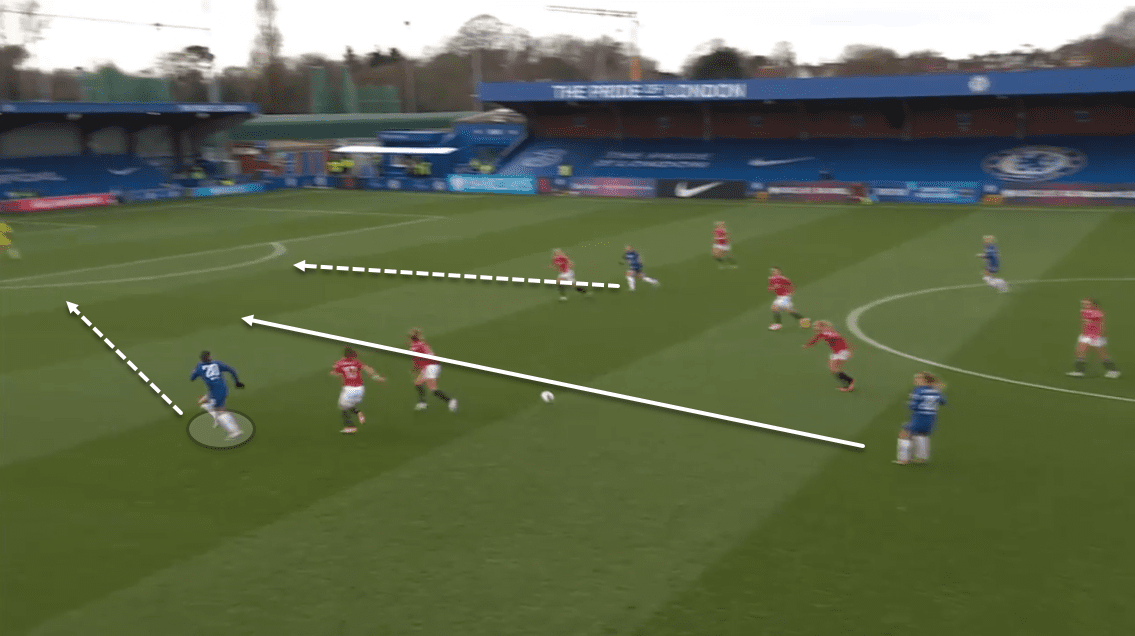
There is significant space that is being exploited by Kerr now and while she takes out two defenders, it leaves Kirby on the far side in a better position giving her the advantage with the defender focused on Kerr’s movement.
Another aspect that is important to look at with Kerr is her ability to drive forward in possession. This combined with her interchanges with nearby teammates enables to carry the ball further and be able to use the space that opens up as has been referenced earlier. Kerr has 2.12 dribbles per 90 minutes (66% success rate) and 8.76 touches in the box, which shows that she both carries the ball forward effectively and manages to get into good spaces in the box.
These short bursts with the ball to progress forward have not been as successful in the deeper areas because teams are wary of stopping Chelsea’s supply early. So it makes sense that Chelsea will want to use Kerr (or England) higher and allow other players to progress it from deep and let the striker take advantage of the spaces further forward.
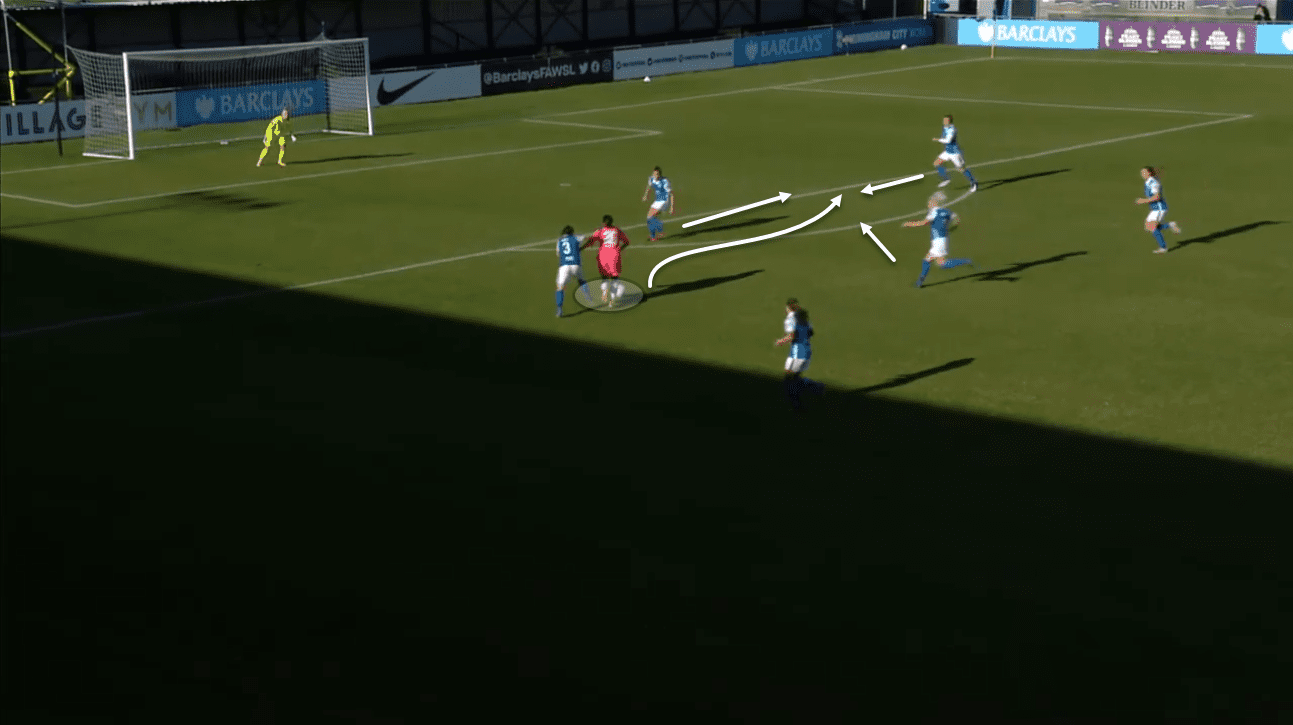
This example shows Kerr picking up possession in the left half space in this attacking transition. As she picks up the ball she is immediately put under pressure but shrugs off the defender. Kerr drives through the remaining defenders to put herself in a better position to shoot. This is something that Chelsea’s forwards need to do effectively because teams will try and compact the space deeper which means finding space becomes more difficult.
Bethany England
England is an eccentric centre-forward playing the role of a hybrid pressing striker. She is a combination of a striker that will break opposition lines but is good at linking up play. Off the ball, England is tactically adept at pressing from the front pressuring the opposition defenders. She tends to press defenders aggressively allowing others around her to apply more pressure and pounce on any mistakes. England’s participation in the forward areas is most apparent in and around the defensive line and box. Most of her playstyle is predicated on two aspects – her movement and positioning and spatial awareness. These attributes are what we come to expect from England when she plays giving Chelsea a different dynamic.
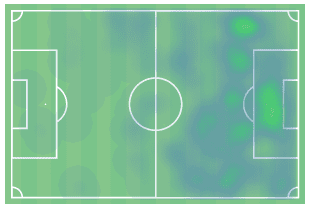
This indicates that England is very much a player who wants to be on the shoulder of defences where she can use her pace and finishing ability to move into 1 v 1 positions. England’s heat map gives us a good indication of her movement and positioning in this regard and it’s clear to see where she is more frequently positioned.
There is a fair proportion of her movement across the final third but one point we can make from this is that she makes runs from the half space into the box. What this means is that she tends to start out in a slightly wider position before making diagonal runs across. Take a closer look at the heat map and this is apparent in the right half space area.
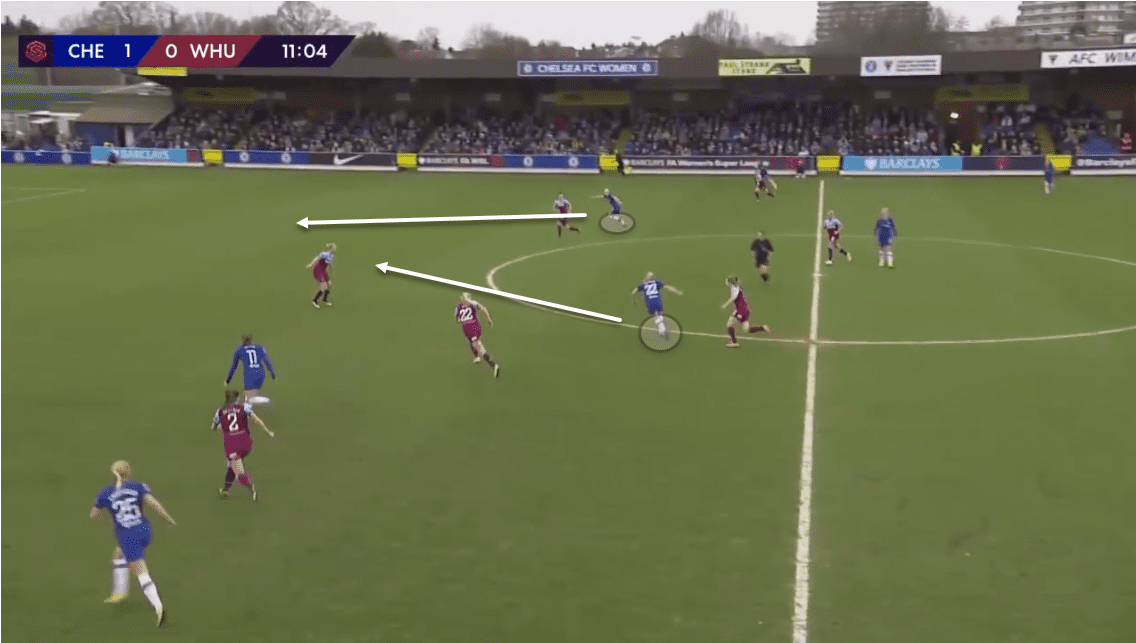
The in-game example against West Ham United Women is a prime example of England taking up good positions to get into a good goal scoring position. First, let’s analyse her starting position, England is two yards behind the last defender and is already pointing to where she wants the ball. Her positioning is in the right half space making it difficult for the defenders to mark her. Chelsea are on the counter-attack with Cuthbert on the ball looking to exploit West Ham’s disjointed defensive line.
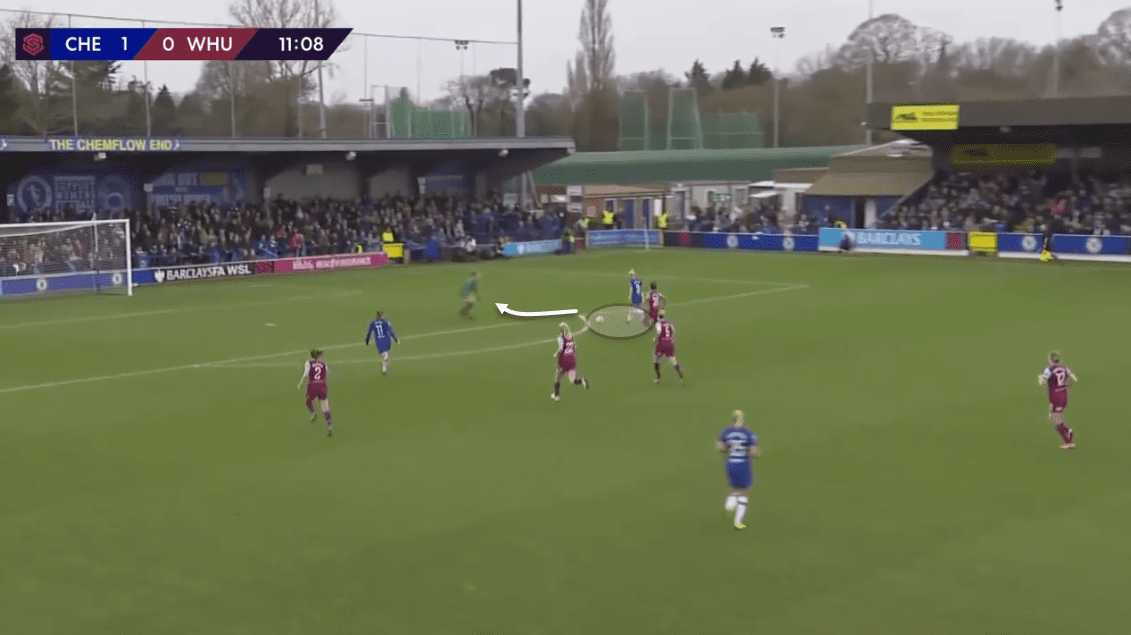
England manages to get in behind and latch onto the through ball where she’s able to round the keeper and score. The main takeaway from this example is the speed of transition that Chelsea had in this counter-attack and how England was in a good position in the half space to take advantage of the space in behind.
It’s not only in these situations that England thrives but she also has the ability to shoot from distance. This season she has averaged 0.35 progressive runs per 90 minutes and 2.77 dribbles per 90 minutes so far, which suggests that she does most of her work off the ball than on it, which is fine given the nature of her play style.
England’s finishing ability is a major aspect of her game that Chelsea have benefited from. Given how many goals she’s scored, we know that England has been a very good finisher but is more than just a penalty box striker. In the 2019/20 season, England attempted 10 shots from outside the box of which four were on target and two goals were scored. Her willingness to shoot from distance gives Chelsea an alternative to work with and produce a moment of magic.
Another aspect of England’s play includes playing in other players and is used as an alternative method of breaking down teams who play with a low block. This is a problem Chelsea face regularly in the FAWSL because of how dominant the Blues are in possession. Poachers usually struggle against these types of opposition but England’s improved ability to link-up creates another dynamic for Chelsea given their tendencies to play wide or central in build-up.
Though it isn’t her strongest aspect, it has improved in the last two seasons given the change in tactics from the 4-2-3-1 of 2018/19 to the 4-4-2 of 2019/20. Further changes this season has meant she needs to be more focused going forward but this is an added bonus.
So who should start?
OK, so we’ve analysed Chelsea’s current attacking system and we’ve overviewed both centre-forwards, but the question remains, who is the perfect fit for the current style of play? To answer this question, we will need to see which forwards’ play style closely matches what Hayes is trying to do. In a nutshell, Chelsea require a striker who possesses excellent movement and finishing but also someone capable of linking play and has excellent spatial awareness.
Based on the analysis we’ve done so far, the most logical choice would be Sam Kerr. The Australian is more flexible who can operate as a central striker but also drops deep and links play. Given she’s played in a few different systems (sole striker at Chicago Red Stars and a pairing at Chelsea last season) Kerr is accustomed to playing either system. From a tactical perspective, this means she understands how the position works from different angles and perspectives. The movement required playing in a strike partnership and a sole striker is different and given Chelsea’s constant, fluid movement, it makes sense. The data also points towards Kerr being a more well-rounded player which can be seen in the dashboard.
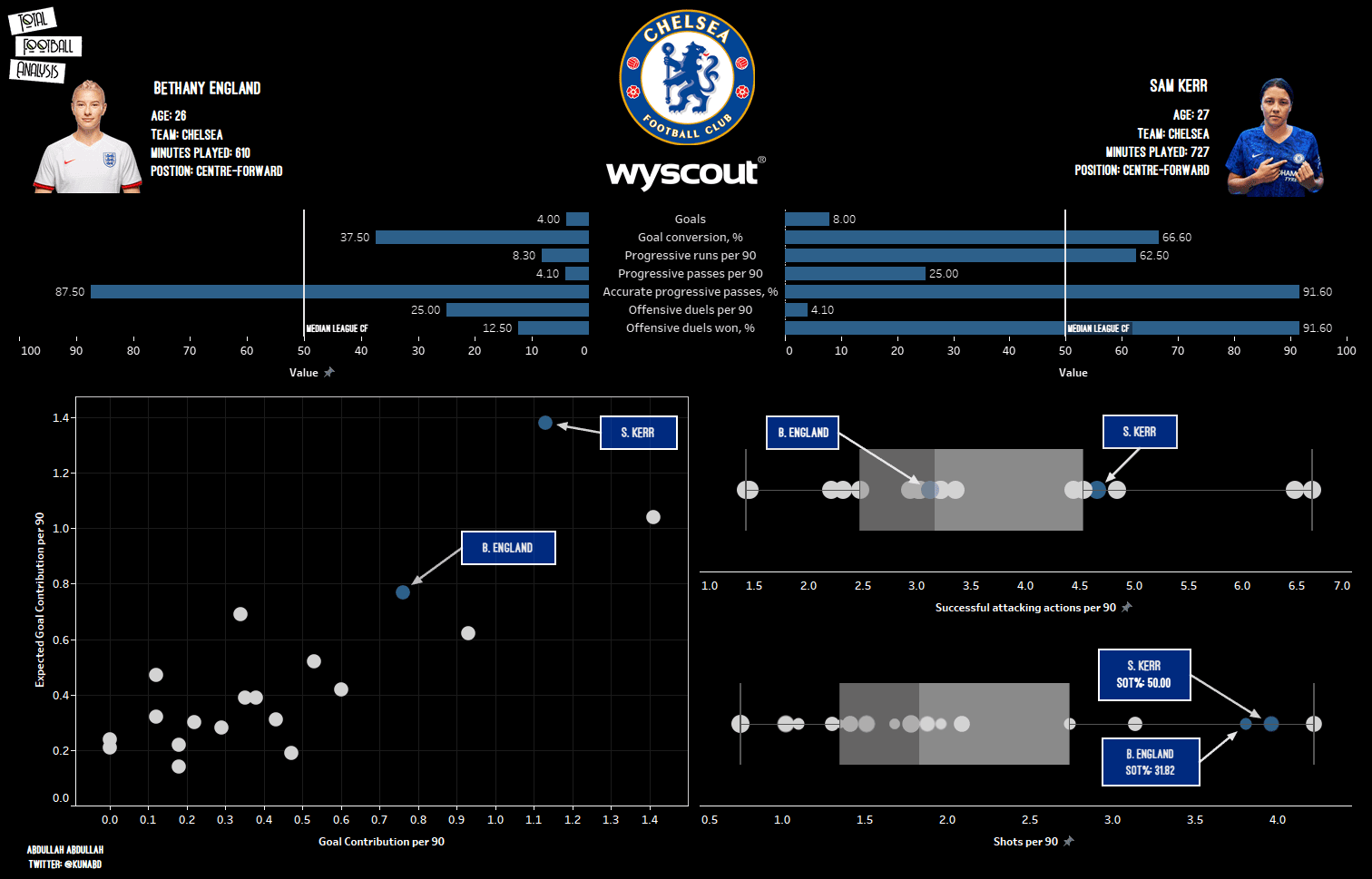
The data seems to be conclusive showing that Kerr is the superior striker in most metrics. The main takeaway comes from the success attacking actions per 90 minutes Gantt chart which illustrate how the two strikers have performed in the league. I’ve filtered out strikers who have played less than 400 minutes. The grey boxes highlight players ranging in the 25% to 75% average mark of players and it’s clear to see that Kerr is the fourth-best performing centre-forward in the FAWSL. England, however, is much further behind in this regard which doesn’t show for good reading. Equally, in progressive passes and runs, Kerr has averaged much higher figures compared to England.
Final remarks
The analysis and data seem to give us conclusive evidence that Kerr is the striker better suited to the attacking system. Though, the reality is that Kerr hasn’t been firing on all cylinders having missed some guilt-edged chances with three chances against Manchester United Women a standout. With Harder and Kirby in the mix, there is still time for Hayes to make tactical tweaks and find better solutions, although, with the way Chelsea are playing now, it’s little wonder she wants to change a winning formula.






Comments